Effects of Nitrogen Fertilizer Application on the Lodging Resistance Traits, Yield, and Quality of Two Gluten Types of Wheat
Abstract
1. Introduction
2. Materials and Methods
2.1. Experimental Site
2.2. Experimental Design
2.3. Measurement Index and Methods
2.3.1. Measurement of Grain Yield and Yield Components
2.3.2. Number of Productive Tillers
2.3.3. Measurement of Vascular Bundle Number, Area, and Mechanical Tissue Thickness
2.3.4. Investigation of Lodging-Related Traits
2.3.5. Measurement of Grain Quality
2.3.6. Measurement of Stem Nutrient Elements
2.4. Statistical Analysis
3. Results
3.1. Vascular Bundles of Stalk
3.2. Mineral Nutrient Element Contents in Wheat Stalks
3.3. Lodging Resistance Index and Its Related Parameters
3.4. Grain Yield
3.5. Grain Qualities
3.6. Analysis of Structural Equation Modeling
4. Discussion
4.1. Effect of Nitrogen and Cultivar on Lodging Resistance in Winter Wheat
4.2. Effects of Nitrogen and Cultivar on Grain Yield
4.3. Effects of Nitrogen and Cultivar on Grain Quality
5. Conclusions
Supplementary Materials
Author Contributions
Funding
Institutional Review Board Statement
Data Availability Statement
Conflicts of Interest
References
- Lu, Y.; Jenkins, A.; Ferrier, R.C.; Bailey, M.; Gordon, I.J.; Song, S.; Huang, J.; Jia, S.; Zhang, F.; Liu, X.; et al. Addressing China’s Grand Challenge of Achieving Food Security While Ensuring Environmental Sustainability. Sci. Adv. 2015, 1, e1400039. [Google Scholar] [CrossRef] [PubMed]
- Announcement by the National Bureau of Statistics on Grain Production Data for 2024. Available online: https://www.stats.gov.cn/sj/zxfb/202412/t20241213_1957744.html (accessed on 6 February 2025).
- Zang, H.; Su, X.; Wang, Y.; Li, G.; Zhang, J.; Zheng, G.; Hu, W.; Shen, H. Automatic Grading Evaluation of Winter Wheat Lodging Based on Deep Learning. Front. Plant Sci. 2024, 15, 1284861. [Google Scholar] [CrossRef] [PubMed]
- Wu, W.; Shah, F.; Duncan, R.W.; Ma, B.L. Grain Yield, Root Growth Habit and Lodging of Eight Oilseed Rape Genotypes in Response to a Short Period of Heat Stress during Flowering. Agric. For. Meteorol. 2020, 287, 107954. [Google Scholar] [CrossRef]
- Zhang, H.; Hu, Y.; Dai, Q.; Xing, Z.; Wei, H.; Sun, C.; Gao, H.; Hu, Q. Discussions on Frontiers and Directions of Scientific and Technological Innovation in China’s Field Crop Cultivation. Sci. Agric. Sin. 2022, 55, 4373–4382. [Google Scholar] [CrossRef]
- Kong, X.; Peng, P.; Li, L.; Zhang, K.; Hu, Z.; Wang, X.; Zhao, G. Wind Lodging-Associated Yield Loss Is Reduced by Wheat Genetic Diversity. Eur. J. Agron. 2022, 133, 126441. [Google Scholar] [CrossRef]
- Zhao, Z.; Duan, S.; Hao, J.; Cui, C.; Yang, Y.; Condon, A.G.; Chen, F.; Hu, Y.-G.; Chen, L. The Dwarf Gene Rht15 Improved Lodging Resistance but Differentially Affected Agronomic and Quality Traits in Durum Wheat. Field Crops Res. 2021, 263, 108058. [Google Scholar] [CrossRef]
- Khan, H.; Parkash, O.; Mamrutha, H.M.; Bairwa, R.K.; Mishra, C.N.; Kumar, R.; Jasrotia, P.; Kumar, S.; Krishnappa, G.; Ahlawat, O.P.; et al. Foliar Application of Chlormequat Chloride Improves Lodging Resistance and Grain Yield in Bread Wheat. Plant Physiol. Rep. 2024, 30, 199–205. [Google Scholar] [CrossRef]
- Stubbs, C.J.; Kunduru, B.; Bokros, N.; Verges, V.; Porter, J.; Cook, D.D.; DeBolt, S.; McMahan, C.; Sekhon, R.S.; Robertson, D.J. Moving toward Short Stature Maize: The Effect of Plant Height on Maize Stalk Lodging Resistance. Field Crops Res. 2023, 300, 109008. [Google Scholar] [CrossRef]
- Niu, Y.; Chen, T.; Zhao, C.; Zhou, M. Lodging Prevention in Cereals: Morphological, Biochemical, Anatomical Traits and Their Molecular Mechanisms, Management and Breeding Strategies. Field Crops Res. 2022, 289, 108733. [Google Scholar] [CrossRef]
- Rozbicki, J.; Ceglińska, A.; Gozdowski, D.; Jakubczak, M.; Cacak-Pietrzak, G.; Mądry, W.; Golba, J.; Piechociński, M.; Sobczyński, G.; Studnicki, M.; et al. Influence of the Cultivar, Environment and Management on the Grain Yield and Bread-Making Quality in Winter Wheat. J. Cereal Sci. 2015, 61, 126–132. [Google Scholar] [CrossRef]
- Sun, H.; Ouyang, S.; Duan, X. Wheat Quality in China-Status and Challenge. Sci. Technol. Cereals Oils Foods 2017, 25, 1–4. [Google Scholar] [CrossRef]
- Bouguyon, E.; Gojon, A.; Nacry, P. Nitrate Sensing and Signaling in Plants. Semin. Cell Dev. Biol. 2012, 23, 648–654. [Google Scholar] [CrossRef] [PubMed]
- Zhu, Y.; Liu, F.; Zhang, Y.; Chang, X.; Wang, D.; Tao, Z.; Wang, Y.; Yang, Y.; Zhao, G. Effect of Nitrogen Treatment on Wheat Yield and Quality in Different Soil Conditions. Crops 2020, 3, 184–190. [Google Scholar]
- Li, C.; Li, W.; Luo, Y.; Jin, M.; Chang, Y.; Cui, H.; Sun, S.; Li, Y.; Wang, Z. Mixed Cropping Increases Grain Yield and Lodging Resistance by Improving the Canopy Light Environment of Wheat Populations. Eur. J. Agron. 2023, 147, 126849. [Google Scholar] [CrossRef]
- Li, L.; He, L.; Li, Y.; Wang, Y.; Ashraf, U.; Hamoud, Y.A.; Hu, X.; Wu, T.; Tang, X.; Pan, S. Deep Fertilization Combined with Straw Incorporation Improved Rice Lodging Resistance and Soil Properties of Paddy Fields. Eur. J. Agron. 2023, 142, 126659. [Google Scholar] [CrossRef]
- Zhang, J.; Li, G.; Song, Y.; Liu, Z.; Yang, C.; Tang, S.; Zheng, C.; Wang, S.; Ding, Y. Lodging Resistance Characteristics of High-Yielding Rice Populations. Field Crops Res. 2014, 161, 64–74. [Google Scholar] [CrossRef]
- Wu, W.; Ma, B.-L.; Fan, J.; Sun, M.; Yi, Y.; Guo, W.; Voldeng, H.D. Management of Nitrogen Fertilization to Balance Reducing Lodging Risk and Increasing Yield and Protein Content in Spring Wheat. Field Crops Res. 2019, 241, 107584. [Google Scholar] [CrossRef]
- Ahmad, I.; Batyrbek, M.; Ikram, K.; Ahmad, S.; Kamran, M.; Misbah; Khan, R.S.; Hou, F.; Han, Q. Nitrogen Management Improves Lodging Resistance and Production in Maize (Zea mays L.) at a High Plant Density. J. Integr. Agric. 2023, 22, 417–433. [Google Scholar] [CrossRef]
- Rehman, M.; Luo, D.; Mubeen, S.; Pan, J.; Cao, S.; Saeed, W.; Chen, P. Progress in Agronomic Crops Lodging Resistance and Prevention: A Review. J. Agron. Crop Sci. 2024, 210, e12785. [Google Scholar] [CrossRef]
- Yang, D.; Cai, T.; Luo, Y.; Wang, Z. Optimizing Plant Density and Nitrogen Application to Manipulate Tiller Growth and Increase Grain Yield and Nitrogen-Use Efficiency in Winter Wheat. PeerJ 2019, 7, e6484. [Google Scholar] [CrossRef]
- Khan, A.; Liu, H.H.; Ahmad, A.; Xiang, L.; Ali, W.; Khan, A.; Kamran, M.; Ahmad, S.; Li, J.C. Impact of Nitrogen Regimes and Planting Densities on Stem Physiology, Lignin Biosynthesis and Grain Yield in Relation to Lodging Resistance in Winter Wheat (Triticum aestivum L.). Cereal Res. Commun. 2019, 47, 566–579. [Google Scholar] [CrossRef]
- Kong, E.; Liu, D.; Guo, X.; Yang, W.; Sun, J.; Li, X.; Zhan, K.; Cui, D.; Lin, J.; Zhang, A. Anatomical and Chemical Characteristics Associated with Lodging Resistance in Wheat. Crop J. 2013, 1, 43–49. [Google Scholar] [CrossRef]
- Trevisan, S.; Khorshidi, A.S.; Scanlon, M.G. Relationship between Nitrogen Functionality and Wheat Flour Dough Rheology: Extensional and Shear Approaches. Food Res. Int. 2022, 162, 112049. [Google Scholar] [CrossRef] [PubMed]
- Edwards, N.M.; Dexter, J.E.; Scanlon, M.G.; Cenkowski, S. Relationship of Creep-Recovery and Dynamic Oscillatory Measurements to Durum Wheat Physical Dough Properties. Cereal Chem 1999, 76, 638–645. [Google Scholar] [CrossRef]
- Melash, A.A.; Ábrahám, É.B. Barriers and Levers to Enhance End-Use Functional Properties of Durum Wheat (Triticum turgidum L.) Grain: An Agronomic Implication. Heliyon 2022, 8, e09542. [Google Scholar] [CrossRef]
- Panayotova, G.; Kostadinova, S.; Valkova, N. Durum Wheat Quality as Affected by Genotype and Nitrogen. Sci. Papers. Ser. A Agron. 2015, 58, 277–283. [Google Scholar]
- Horvat, D.; Šimić, G.; Dvojković, K.; Ivić, M.; Plavšin, I.; Novoselović, D. Gluten Protein Compositional Changes in Response to Nitrogen Application Rate. Agronomy 2021, 11, 325. [Google Scholar] [CrossRef]
- Wang, R.; Wang, H.; Jiang, G.; Yin, H.; Che, Z. Effects of Nitrogen Application Strategy on Nitrogen Enzyme Activities and Protein Content in Spring Wheat Grain. Agriculture 2022, 12, 1891. [Google Scholar] [CrossRef]
- Fu, S.; Liu, X.; Ma, Y.; Li, H.; Zhen, Y.; Zhang, Z.; Wang, Y.; Men, M.; Peng, Z. Effects of Nitrogen Supply Forms on the Quality and Yield of Strong and Medium-gluten Wheat Cultivars. J. Plant Nutr. Fertil. 2022, 28, 83–93. [Google Scholar]
- Tian, P.; Fu, W.; Hou, Z.; Huang, Y.; Wang, Y. The effect of nitrogen application on the yield, quality, and nutrient absorption patterns of wheat with different strength levels. Agric. Henan 2021, 17, 16–19+42. [Google Scholar]
- Meng, Y.; Qiu, W.; Fan, J. A New High-yield Wheat Variety-Yumai49-198. Bull. Agric. Sci. Technol. 2006, 6, 57–58. [Google Scholar]
- Lyu, L.; Liu, Y.; Zhao, A.; Li, Z.; Li, H.; Chen, X. Breeding of a New Winter Wheat Variety Jimai325 with High Yield, Drought Resistant and Wide Adaptability and Breeding Strategy. J. Hebei Agric. Sci. 2021, 25, 79–83. [Google Scholar]
- Song, Y.; Cao, B. Characteristics and Production Application Value of the new wheat variety Xinong979. J. Henan Inst. Sci. Technol. (Nat. Sci. Ed.) 2008, 1, 17–18. [Google Scholar]
- Li, H. A new high-quality and stron-gluten wheat variety-Jimai44. Agric. Knowl. 2019, 17, 62. [Google Scholar]
- Kaack, K.; Schwarz, K.U.; Brander, P.E. Variation in Morphology, Anatomy and Chemistry of Stems of Miscanthus Genotypes Differing in Mechanical Properties. Ind. Crops Prod. 2003, 17, 131–142. [Google Scholar] [CrossRef]
- Ma, Q.; Qian, C.; Jia, W.; Wu, Y.; Li, C.; Ding, J.; Zhu, M.; Guo, W.; Zhu, X. Effect of Coated Urea Type and Fertilization Pattern on Lodging Resistance and Yield of Wheat Following Rice. Chin. J. Eco-Agric. 2022, 30, 1774–1783. [Google Scholar] [CrossRef]
- Zhou, Y.; Li, F.; Peng, S.; Wang, D.; Man, J. Current Situation and Development Countermeasures of Weak-Gluten Wheat Industry in China. J. Huazhong Agric. Univ. 2025. Available online: https://link.cnki.net/urlid/42.1181.S.20250220.1534.004 (accessed on 1 March 2025).
- AACC (American Association of Cereal Chemists). Approved Methods of the AACC, 11th ed.; AACC: St. Paul, MN, USA, 2005; Available online: https://www.cerealsgrains.org/resources/Methods/Pages/default.aspx (accessed on 1 March 2025).
- Cantarelli, M.A.; Pellerano, R.G.; Del Vitto, L.A.; Marchevsky, E.J.; Camiña, J.M. Characterisation of Two South American Food and Medicinal Plants by Chemometric Methods Based on Their Multielemental Composition. Phytochem. Anal. 2010, 21, 550–555. [Google Scholar] [CrossRef] [PubMed]
- Li, B.; Zhang, J.; Cui, H.; Jin, L.; Dong, S.; Liu, P.; Zhao, B. Effects of Potassium Application Rate on Stem Lodging Resistance of Summer Maize under High Yield Conditions. Acta Agron. Sin. 2012, 38, 2093–2099. [Google Scholar] [CrossRef]
- Li, W.; Han, M.; Pang, D.; Chen, J.; Wang, Y.; Dong, H.; Chang, Y.; Jin, M.; Luo, Y.; Li, Y.; et al. Characteristics of lodging resistance of high-yield winter wheat as affected by nitrogen rate and irrigation managements. J. Integr. Agric. 2022, 21, 1290–1309. [Google Scholar] [CrossRef]
- Acero-Camelo, A.; Pabón, M.L.; Fischer, G.; Carulla-Fornaguera, J. Optimum harvest time for Kikuyu grass (Cenchrus clandestinus) according to the number of leaves per tiller and nitrogen fertilization. Rev. Fac. Nac. Agron. Medellín 2020, 73, 9243–9253. [Google Scholar] [CrossRef]
- Zheng, M.; Chen, J.; Shi, Y.; Li, Y.; Yin, Y.; Yang, D.; Luo, Y.; Pang, D.; Xu, X.; Li, W.; et al. Manipulation of lignin metabolism by plant densities and its relationship with lodging resistance in wheat. Sci. Rep. 2017, 7, 41805. [Google Scholar] [CrossRef] [PubMed]
- Zheng, Q.; Zhou, T.; Wang, Y.; Cao, X.; Wu, S.; Zhao, M.; Wang, H.; Xu, M.; Zheng, B.; Zheng, J.; et al. Pretreatment of wheat straw leads to structural changes and improved enzymatic hydrolysis. Sci. Rep. 2018, 8, 1321. [Google Scholar] [CrossRef] [PubMed]
- Wang, X.; Wang, Z.; Zhang, X.; Zhu, Y.; Guo, T.; Wang, C. Effects of Nitrogen Application Rate on Tillering, Post—anthesis Dry Matter Accumulation and Yield in High Yielding Wheat. Acta Agric. Boreali-Occident. Sin. 2013, 22, 1–8. [Google Scholar]
- Hao, T.; Chen, R.; Jia, J.; Zhao, C.; Du, Y.; Li, W.; Zhao, L.; Duan, H. Enhancing Wheat Gluten Content and Processing Quality: An Analysis of Drip Irrigation Nitrogen Frequency. Plants 2023, 12, 3974. [Google Scholar] [CrossRef]
- GB/T 17320-2013; Quality Classification of Wheat Varieties. General Administration of Quality Supervision, Inspection and Quarantine of China, Standardization Administration of China: Beijing, China, 2013.
- Žilić, S.; Barać, M.; Pešić, M.; Dodig, D.; Ignjatović-Micić, D. Characterization of Proteins from Grain of Different Bread and Durum Wheat Genotypes. Int. J. Mol. Sci. 2011, 12, 5878–5894. [Google Scholar] [CrossRef]
- Si, Z.; Qin, A.; Liang, Y.; Duan, A.; Gao, Y. A Review on Regulation of Irrigation Management on Wheat Physiology, Grain Yield, and Quality. Plants 2023, 12, 692. [Google Scholar] [CrossRef]
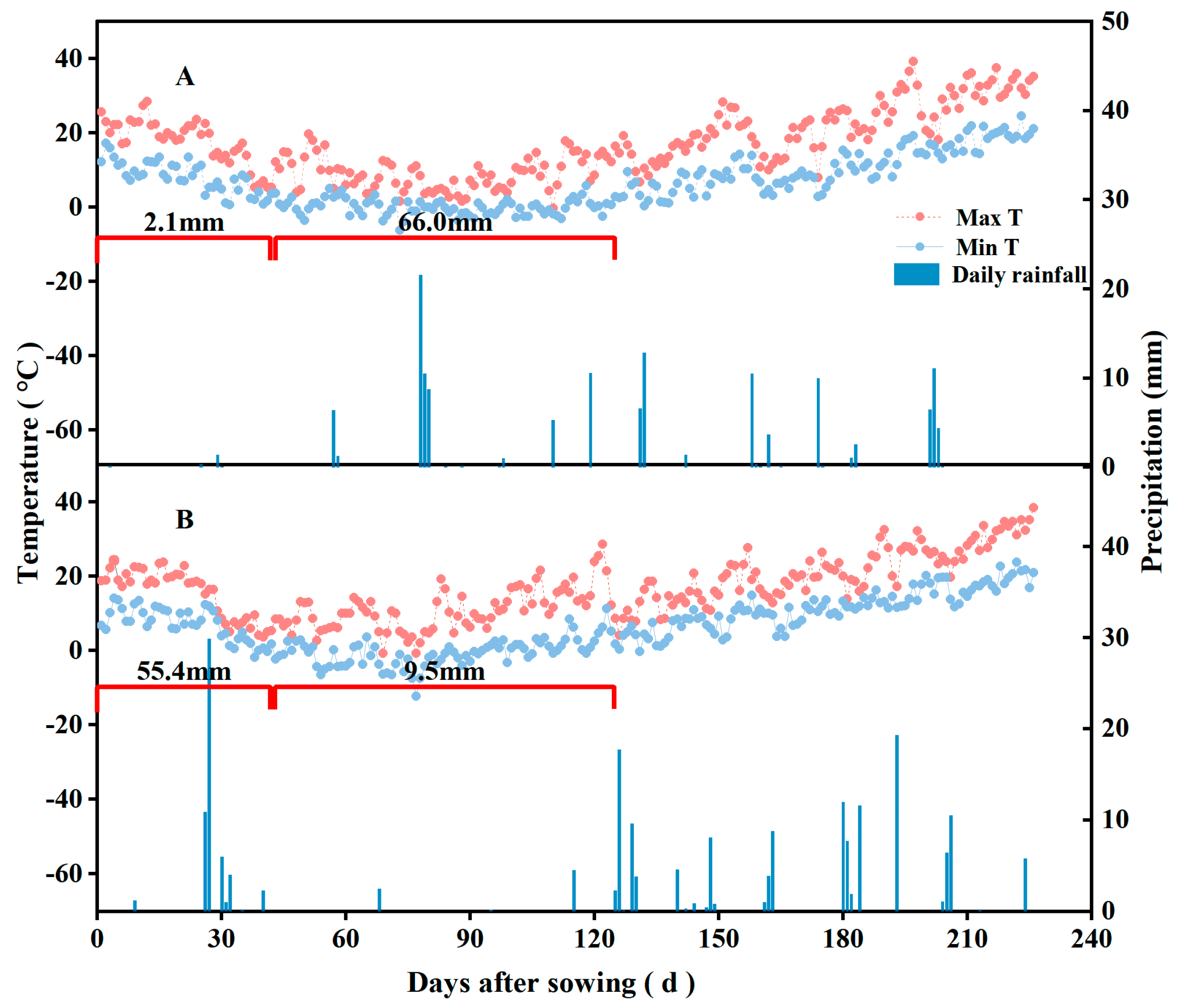
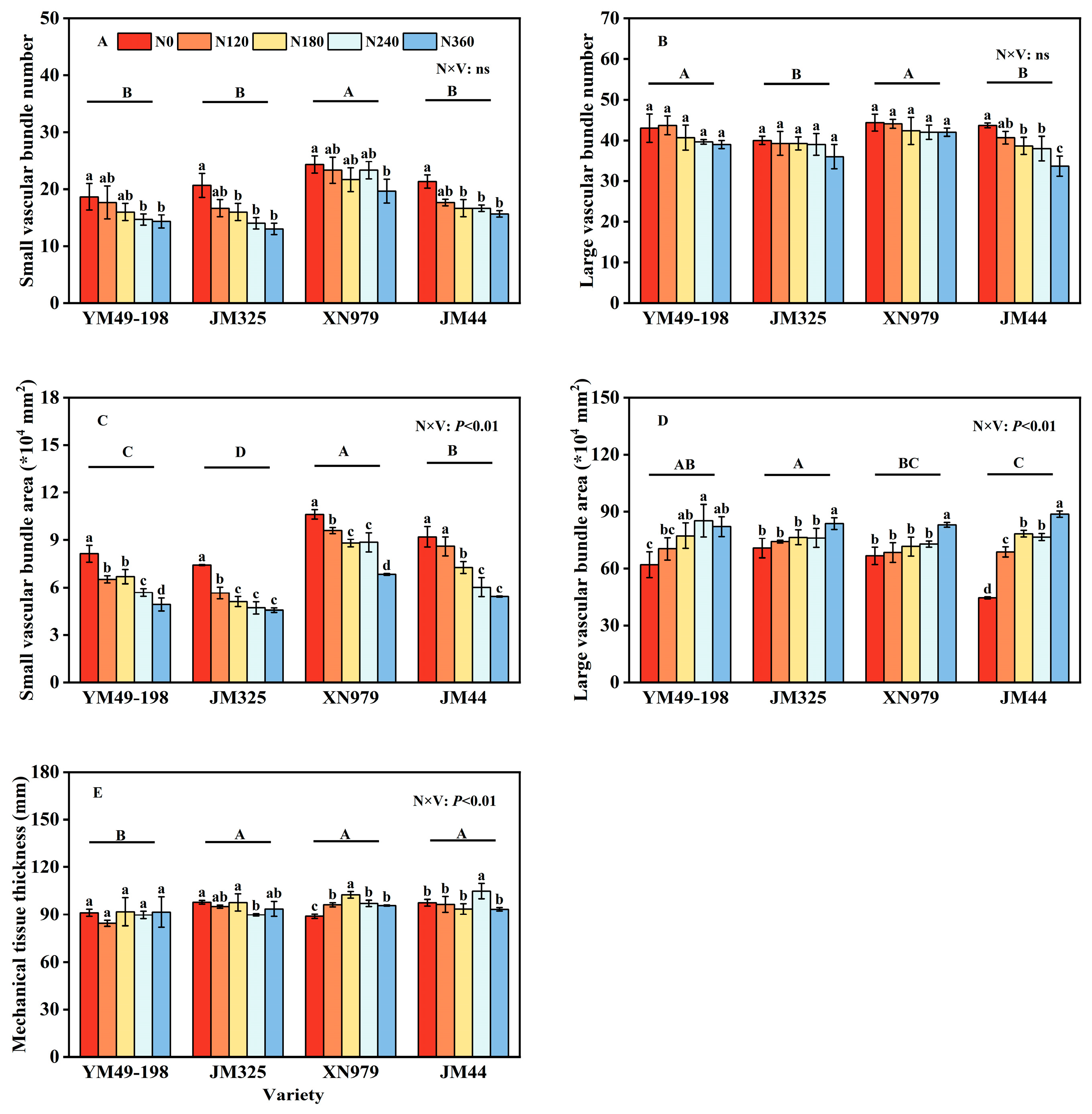
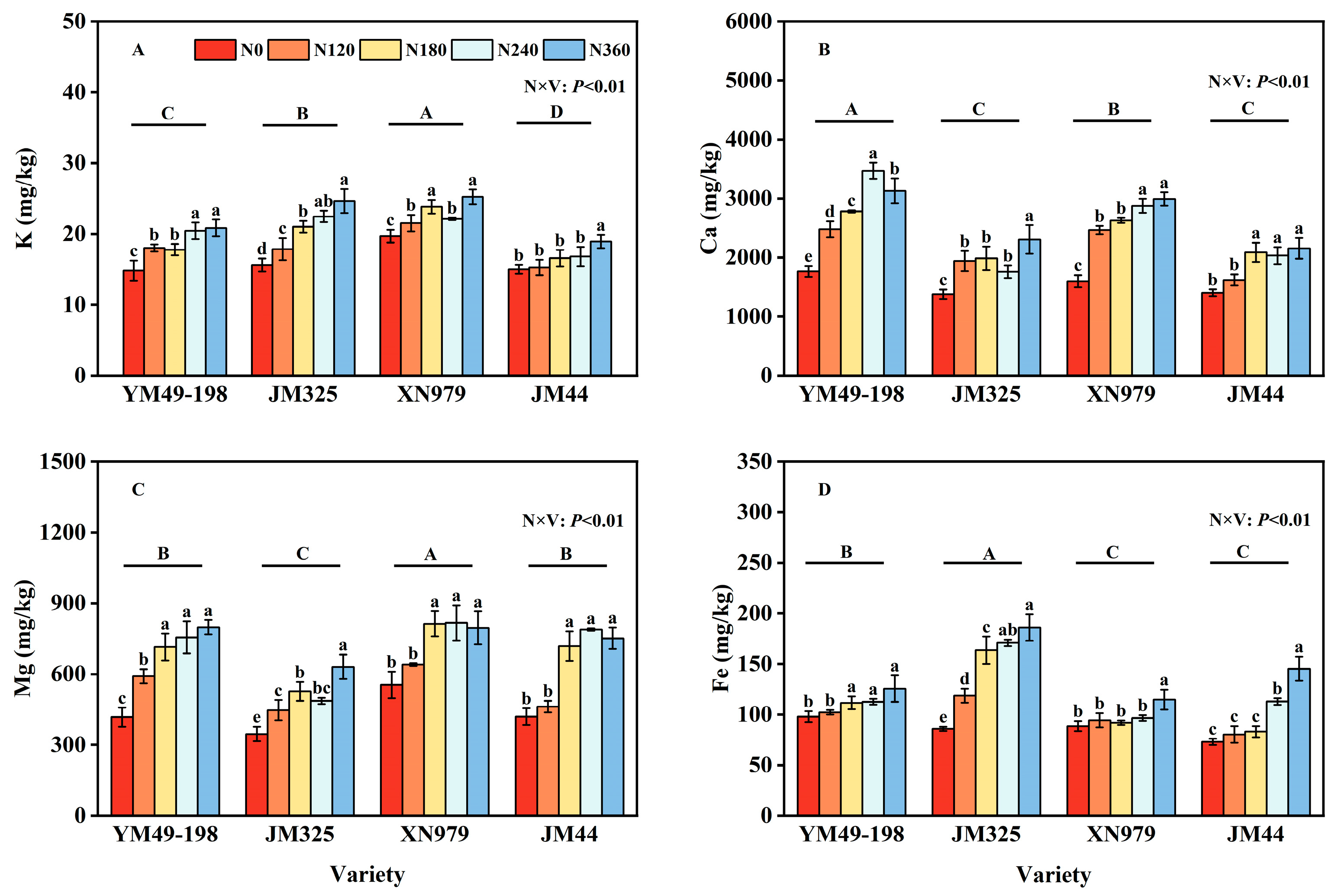

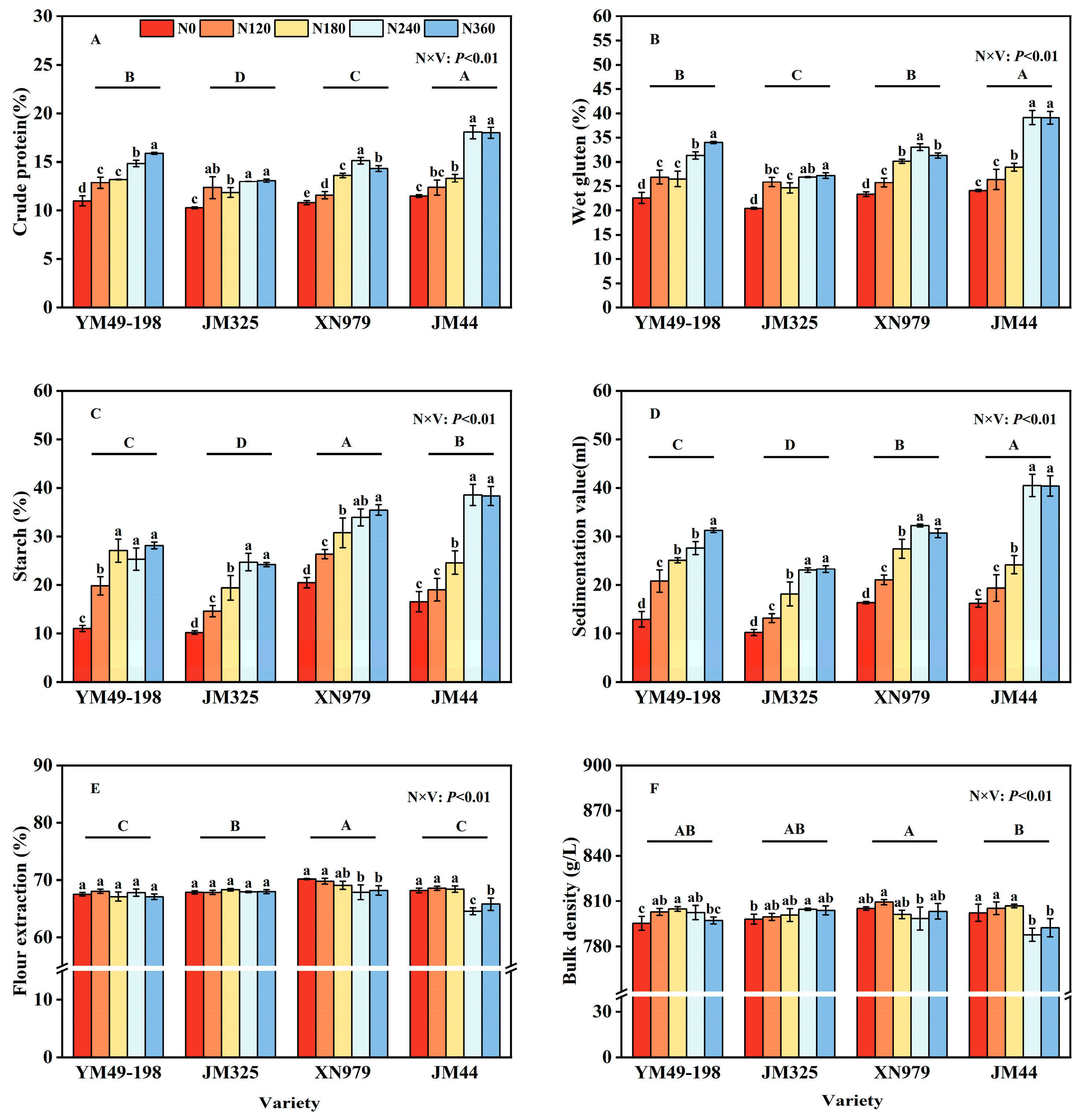
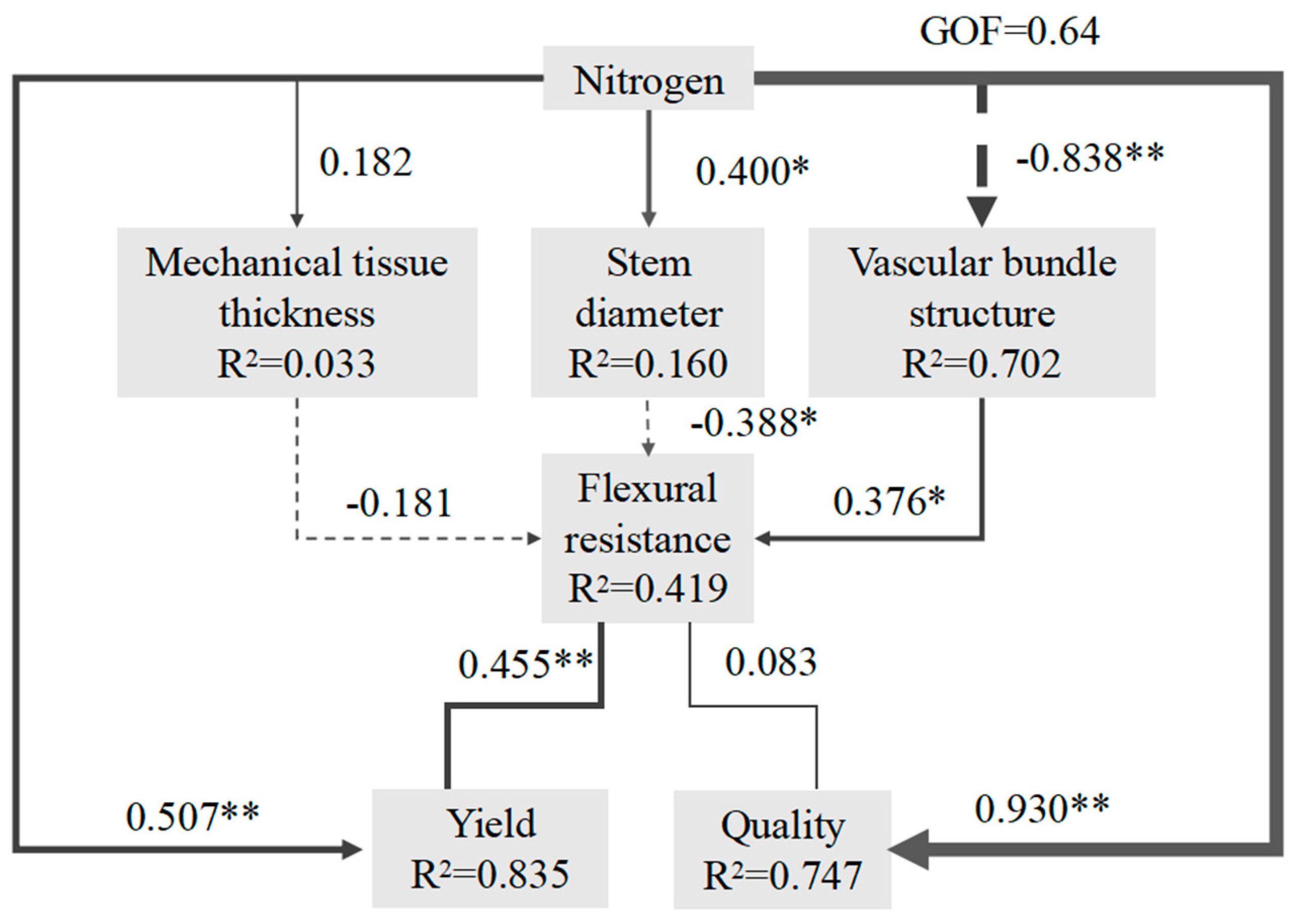
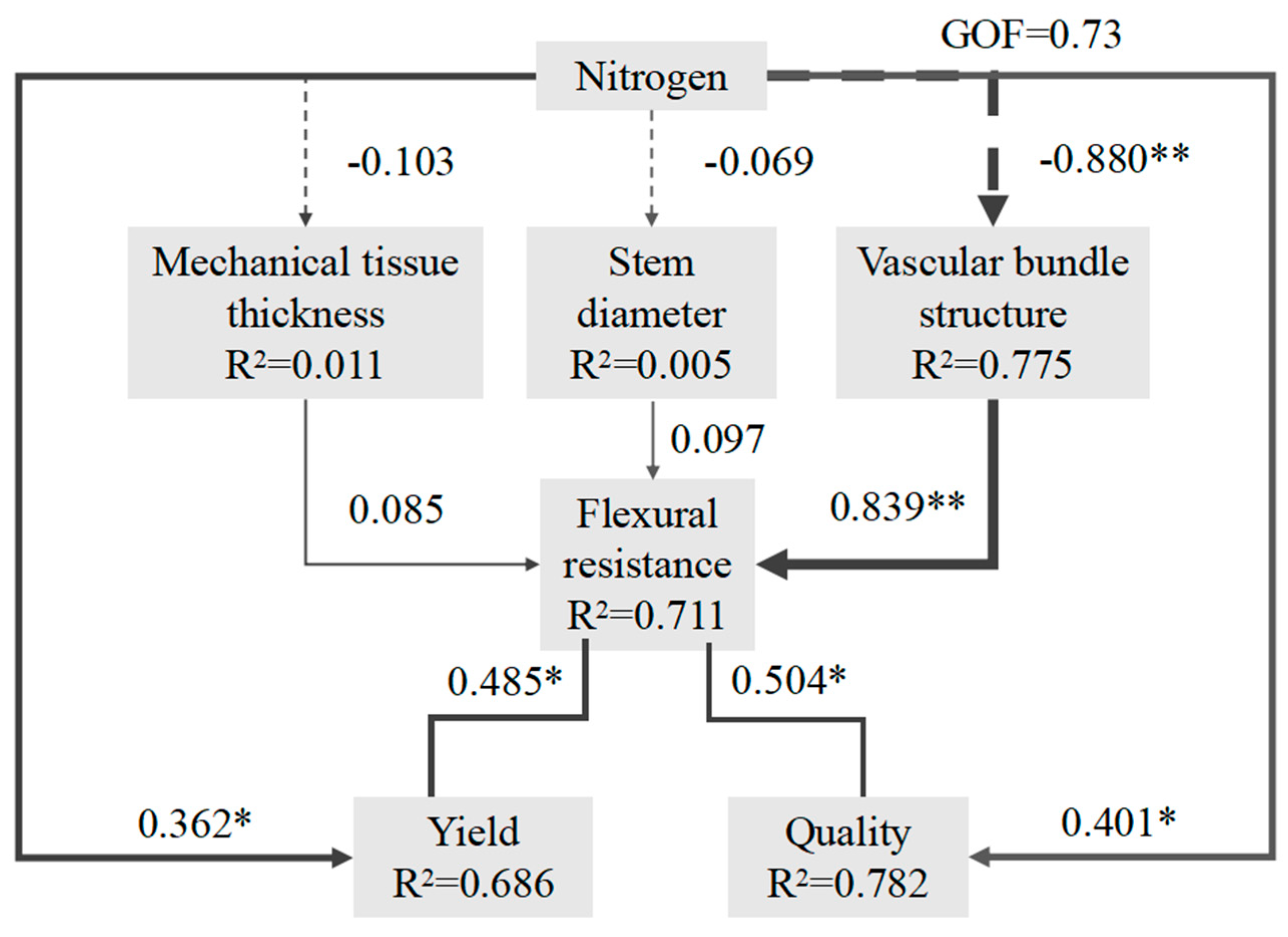
| Variety | N Rate (kg·ha−1) | Plant Height (cm) | Stem Diameter (mm) | Gravity Center Height (cm) | Stem Breaking Strength (N) | Lodging Resistance Index |
|---|---|---|---|---|---|---|
| YM49-198 | N0 | 62.9 d | 4.8 a | 37.2 d | 13.1 a | 35.1 c |
| N120 | 69.3 c | 4.7 a | 40.6 c | 12.7 ab | 31.1 b | |
| N180 | 72.4 bc | 4.7 a | 44.7 ab | 12.8 ab | 28.5 ab | |
| N240 | 75.8 ab | 4.7 a | 43.8 b | 9.3 b | 21.2 a | |
| N360 | 77.2 a | 3.9 b | 47.2 a | 4.5 c | 9.5 a | |
| Mean | 71.5 BC | 4.5 AB | 42.7 B | 10.5 B | 25.1 B | |
| JM325 | N0 | 62.1 d | 4.5 a | 36.0 c | 20.1 a | 55.9 a |
| N120 | 73.7 c | 5 a | 42.8 b | 11.9 b | 27.6 b | |
| N180 | 80.1 b | 4.8 a | 48.1 a | 13.4 ab | 27.6 b | |
| N240 | 85.3 a | 4.7 a | 47.8 a | 10.9 b | 22.8 b | |
| N360 | 81.1 ab | 4.1 a | 47.8 a | 11.6 b | 24.4 b | |
| Mean | 76.5 A | 4.6 AB | 44.5 A | 13.6 A | 31.6 A | |
| XN979 | N0 | 57.4 c | 4.9 a | 32.7 c | 9.9 a | 30.4 a |
| N120 | 68.7 b | 5.2 a | 42.4 b | 9.4 a | 22.2 b | |
| N180 | 73.7 ab | 4.7 a | 45.6 b | 9.2 a | 20.3 b | |
| N240 | 72.9 ab | 4.6 a | 49.4 a | 6.4 b | 13.0 c | |
| N360 | 75.6 a | 5.1 a | 45.3 b | 5.6 b | 12.3 c | |
| Mean | 69.6 C | 4.9 A | 43.1 B | 8.1 C | 19.6 C | |
| JM44 | N0 | 64.4 b | 4.6 a | 36.4 d | 12.8 a | 35.0 a |
| N120 | 68.8 b | 4.3 a | 40.7 c | 12.2 ab | 30.0 ab | |
| N180 | 74.6 a | 4.6 a | 40.3 c | 10.3 bc | 25.6 b | |
| N240 | 77.2 a | 3.9 a | 47.7 a | 8.3 cd | 17.6 c | |
| N360 | 76.5 a | 4.1 a | 44.0 b | 7.3 d | 16.6 c | |
| Mean | 72.3 B | 4.3 B | 41.8 B | 10.2 B | 25 B | |
| N | 17.8 ** | 3.7 * | 5.3 ** | 15.5 ** | 16.0 ** | |
| V | 79.0 ** | ns | 74.6 ** | 17.0 ** | 44.5 ** | |
| N × V | 2.1 ** | ns | 4.0 ** | ns | 3.5 ** |
| Variety | N Rate (kg·ha−1) | Plant Height (cm) | Stem Diameter (mm) | Gravity Center Height (cm) | Stem Breaking Strength (N) | Lodging Resistance Index |
|---|---|---|---|---|---|---|
| YM49-198 | N0 | 74.2 b | 4.3 a | 42.9 b | 13.9 a | 32.5 a |
| N120 | 76.3 b | 3.9 a | 44.8 ab | 10.6 b | 23.7 b | |
| N180 | 78.8 a | 4.2 a | 47.7 a | 6.2 c | 12.9 c | |
| N240 | 75.8 b | 4.2 a | 45.3 ab | 5.5 cd | 12.2 cd | |
| N360 | 77.7 a | 4.2 a | 46.0 ab | 4.5 d | 9.7 d | |
| Mean | 76.5 B | 4.2 A | 45.3 D | 8.1 A | 18.2 A | |
| JM325 | N0 | 77.6 b | 4.3 a | 44.8 c | 13.2 a | 29.5 a |
| N120 | 87.5 a | 4.1 a | 47.8 b | 9.7 b | 20.2 b | |
| N180 | 88.5 a | 4.2 a | 51.4 a | 6.9 c | 13.4 c | |
| N240 | 86.8 a | 4.3 a | 50.5 a | 7.0 c | 13.9 c | |
| N360 | 90.6 a | 4.1 a | 50.7 a | 5.6 c | 11 c | |
| Mean | 86.2 A | 4.2 A | 49.0 B | 8.5 A | 17.6 A | |
| XN979 | N0 | 67.2 c | 3.9 a | 38.7 d | 8.6 a | 22.1 a |
| N120 | 78.1 b | 4.4 a | 47.2 c | 6.8 b | 14.3 b | |
| N180 | 77.2 b | 4.0 a | 45.1 b | 5.9 b | 13 b | |
| N240 | 79.0 b | 4.0 a | 50.3 a | 4.0 c | 7.9 c | |
| N360 | 82.1 a | 4.3 a | 51.8 a | 3.7 c | 7.2 c | |
| Mean | 76.7 B | 4.1 A | 46.6 C | 5.8 C | 12.9 C | |
| JM44 | N0 | 70.2 c | 3.1 b | 41.0 d | 10.8 a | 26.3 a |
| N120 | 87.7 b | 4.4 a | 47.8 c | 7.5 b | 15.8 b | |
| N180 | 89.8 b | 4.0 a | 50.3 c | 6.5 bc | 12.9 c | |
| N240 | 87.3 b | 3.9 a | 53.7 b | 6.3 bc | 11.7 cd | |
| N360 | 93.0 a | 4.2 a | 59.0 a | 5.9 c | 10 d | |
| Mean | 85.6 A | 3.9 A | 50.4 A | 7.4 B | 15.3 B | |
| N | 147.6 ** | ns | 39.7 ** | 33.8 ** | 25.0 ** | |
| V | 112.0 ** | ns | 89.0 ** | 139.0 ** | 192.7 ** | |
| N × V | 10.4 ** | 3.1 ** | 12.2 ** | 5.7 ** | 3.9 ** |
Disclaimer/Publisher’s Note: The statements, opinions and data contained in all publications are solely those of the individual author(s) and contributor(s) and not of MDPI and/or the editor(s). MDPI and/or the editor(s) disclaim responsibility for any injury to people or property resulting from any ideas, methods, instructions or products referred to in the content. |
© 2025 by the authors. Licensee MDPI, Basel, Switzerland. This article is an open access article distributed under the terms and conditions of the Creative Commons Attribution (CC BY) license (https://creativecommons.org/licenses/by/4.0/).
Share and Cite
Hu, X.; Tian, P.; Fu, W.; Tian, Z.; Du, M.; Chang, Z.; Ye, Y.; Meng, X.; Wang, Y. Effects of Nitrogen Fertilizer Application on the Lodging Resistance Traits, Yield, and Quality of Two Gluten Types of Wheat. Agriculture 2025, 15, 637. https://doi.org/10.3390/agriculture15060637
Hu X, Tian P, Fu W, Tian Z, Du M, Chang Z, Ye Y, Meng X, Wang Y. Effects of Nitrogen Fertilizer Application on the Lodging Resistance Traits, Yield, and Quality of Two Gluten Types of Wheat. Agriculture. 2025; 15(6):637. https://doi.org/10.3390/agriculture15060637
Chicago/Turabian StyleHu, Xueling, Peiyu Tian, Wen Fu, Zhihao Tian, Mengdi Du, Zhishang Chang, Youliang Ye, Xiangping Meng, and Yang Wang. 2025. "Effects of Nitrogen Fertilizer Application on the Lodging Resistance Traits, Yield, and Quality of Two Gluten Types of Wheat" Agriculture 15, no. 6: 637. https://doi.org/10.3390/agriculture15060637
APA StyleHu, X., Tian, P., Fu, W., Tian, Z., Du, M., Chang, Z., Ye, Y., Meng, X., & Wang, Y. (2025). Effects of Nitrogen Fertilizer Application on the Lodging Resistance Traits, Yield, and Quality of Two Gluten Types of Wheat. Agriculture, 15(6), 637. https://doi.org/10.3390/agriculture15060637





